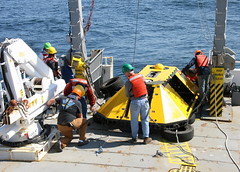Oregon State University will continue to host and lead a federal federal/academic research partnership to study marine resources in the Pacific Northwest, the National Oceanic and Atmospheric Administration announced yesterday.
The award means that NOAA will continue funding the Cooperative Institute for Marine Resource Studies (CIMRS), which was established at Oregon State in 1982, for at least five and up to 10 more years.
Following a competitive application process, NOAA chose Oregon State to continue to administer the CIMRS partnership, which focuses on marine resources such as hydrothermal vents, seafloor volcanoes, marine mammals, and marine ecosystems. Research will also seek to improving protection and restoration of these marine resources.
Based – along with three NOAA labs – at OSU’s Hatfield Marine Science Center in Newport, CIMRS is one of 18 NOAA cooperative institutes nationwide. The agency funds cooperative institutes at universities with strong research programs relevant to its mission.
Read more:




